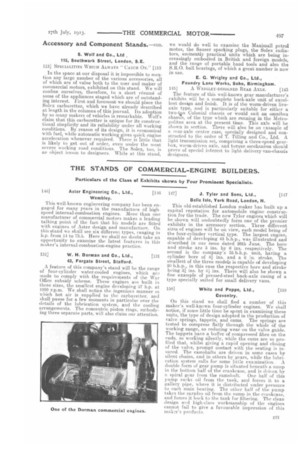THE STANDS OF COMMERCIAL-ENGINE BUILDERS.
Page 27

If you've noticed an error in this article please click here to report it so we can fix it.
Particulars of the Class of exhibits shown by Four Prominent Specialists.
146] Aster Engineering Co., Ltd., [146 147] J. Tyler and Sons, Ltd., [147 Wembley. Belle Isle, York Road, London, N.
This well-known engineering company has been engaged for many years in the manufacture of high. speed internal-combustion engines. More than -one manufacturer of commercial motors makes a leading talking point of the fact that his models are fitted with engines of Aster design and manufacture. On this stand we shall see six different types, ranging in h.p. from 14 to 73.5. Here we shall no doubt take an opportunity to examine the latest features in this maker's internal-combustion-engine practice.
131] W. H. Dorman and Co., Ltd., [131
43, Forgate Street, Stafford.
A feature of this company's stand will bc the range of four-cylinder water-cooled engines, which are made to comply with the requirements of the War Office subsidy scheme. These engines are built in three sizes, the smallest engine developing 37 h,p, at 1000 r.p.m. We shall notice the. ingenious manner in which hot air is supplied to the carburetter, and shall pause for a few moments in particular over the details of the lubrication system, and the cooling arrangements. The concentric piston rings, embodying three separate parts, will also claim our attention. This old-established London maker has built up a capital reputation for automobile engine construction for the trade. The new Tylor engines which will be shown will undoubtedly form one of the premier exhibits in the accessory section. Three diffevent size's of engines will be on view, each model being of the four-cylinder vertical type. The largest engine, capable of developing 45 b.h.p., was illustrated and described in our issue dated 26th June. The bore and stroke are 5 ins. by 6 ins. respectively. The second is the company's 35-b.h.p. unit, having a. cylinder bore of 41 ins, and a 6 in. stroke. The smallest of the three models is capable of developing 20 b.h.p., in this case the respective bore and stroke being 31 ins. by 4i ins. There will also be shown a fine example of pressed-steel back-axle casing of a type specially suited for small delivery vans.
150] White and Poppe, Ltd., [150 Coventry.
On this stand we shall find a Dumber of this maker's well-known four-cylinder engines. We shall notice, if some little time be spent in examining these units, the type of design adopted in the production of valve springs, tappets, and cams. The springs are tested to compress flatly through the whole of the working range, so reducing wear on the valve guide. The tappets have a buffer of compressed fibre on the ends, so working silently, while the cams are so profiled that, whilst giving a rapid opening and closing of the valve, prompt contact with the seating is insured. The camshafts are driven in some. cases by silent chains, and in others by gears, while the lubrication system calls for some little examination. A double form of gear pump is situated beneath a sump in the bottom half of the crankcase, and is driven by a spiral gear from the camshaft. One half of this pump sucks oil from the tank, and forces it to a gallery pipe, where it is distributed under pressure to each main bearing. The other half of the pump takes the surplus oil from the sump in the crankcase, and forces it baek to the tank for filtering. The clean design and high-chess workmanship of the engines cannot fail to give a favourable impression of this m ak er's products.














































